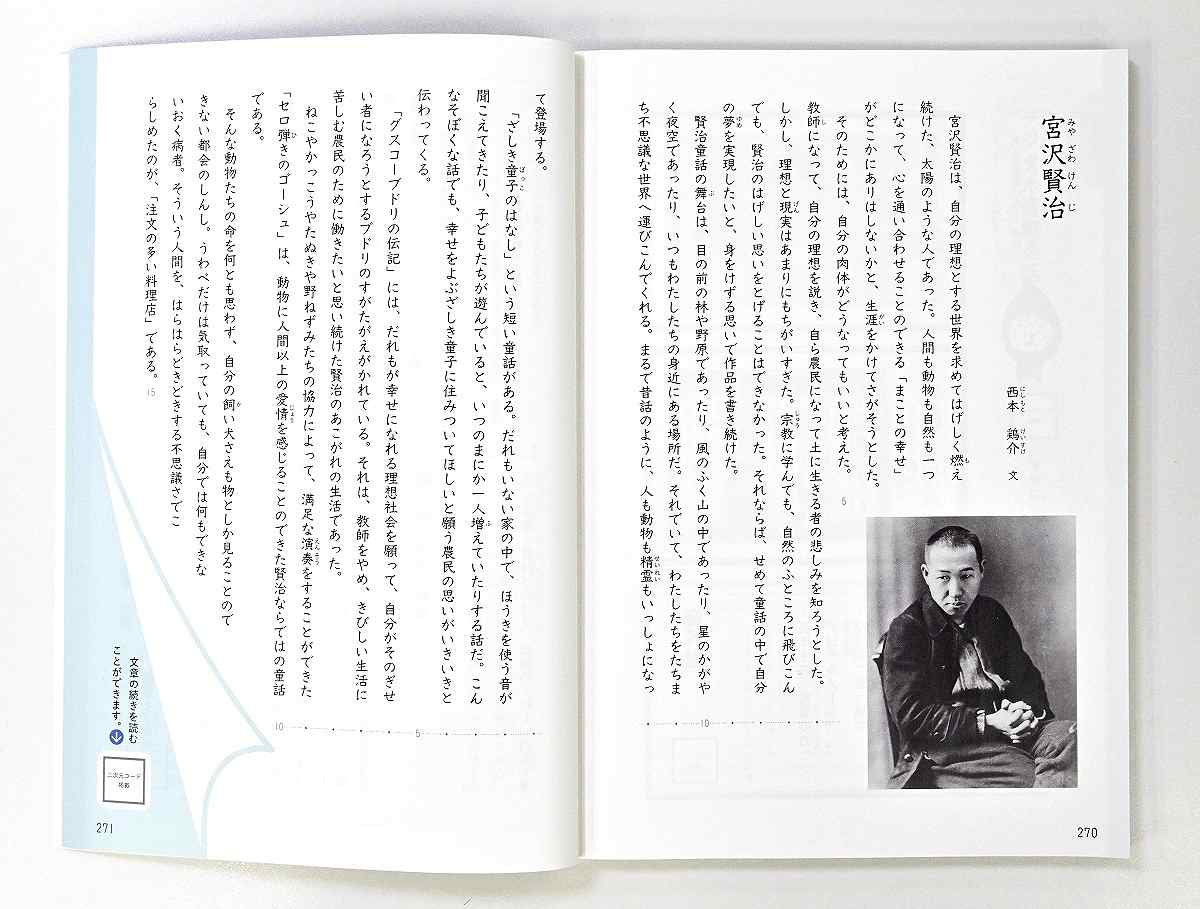
An image of a new printed textbook’s article on Kenji Miyazawa with a place for a QR code at the lower left corner for students to read the rest of the article digitally.
16:42 JST, March 29, 2023
Coming soon to elementary schools in Japan are QR codes in all textbooks.
From the academic year that begins in April 2024, all new textbooks will include the codes so students can use the provided tablets to access digital educational materials online such as videos and audio.
One such textbook enables students to access over 1,000 materials via QR codes, standing out as an example of integrating traditional printed materials with digital resources.
While the expectation is that using a wide variety of materials can be effective, there are concerns about the possible impact on children’s attitude toward learning and their health.
In Tokyo Shoseki Co.’s Japanese language textbook for fifth graders, a QR code will be included in the biography of poet and author Kenji Miyazawa. Only two pages are printed in the textbook. The rest can be read by scanning the QR code at the lower left corner of the second page using a digital device.
Although this digital material is a supplement to the print textbook, an official in charge at the publisher said, “We have enhanced the contents digitally while reducing the weight of the print textbook.”
Utilizing digital educational materials will enable publishers to include information that cannot be contained in printed textbooks.
In the textbook screening for the 2018 school year, 155 out of 164 textbooks included QR codes. But the number of insertions was limited. This time, textbook publishers said they have greatly increased the number of QR codes inserted. The previous textbook screening saw Tokyo Shoseki’s Japanese language textbook for elementary students with 55 QR codes inserted. For the 2024 school year, there are over 600 QR codes in the new textbook.
During the latest screening period, publishers vied to improve their digital educational materials. For example, some digital functions might include automatically marking answers in arithmetic or offering a field guide to living creatures.
Pros and cons
“With one digital device supplied to each student, digital learning materials have become as indispensable as pencils and erasers,” said an official of Sanseido Co., a leading publisher.
“Digital educational materials are useful as they will enable students to, for instance, repeatedly check the methods of scientific experiments and solid figures in arithmetic, and practice calligraphy,” said Koichiro Oji, head of the Japan Federation of Primary School Principals Association.
Printed textbooks are screened in detail by experts over the course of a year. Digital educational materials, however, are not subject to authorization as they are seen as being supplementary.
According to the textbook authorization standards, the insertion of QR codes in textbooks is allowed if it is confirmed that digital materials are “closely related to the contents of the textbook” and “do not constitute referencing information that is inappropriate for students.”
Local boards of education select textbooks to be used for their elementary schools from among those that have passed the ministry’s screening. As many teachers are not familiar with the use of digital teaching materials, there has been some puzzlement voiced as well.
“If there are too many QR codes, I’m afraid children may not be able to focus on the printed textbooks,” said a principal of a public elementary school in the Tohoku region. “It will further reduce opportunities for children to think, such as learning through looking up information in a dictionary.”
Health impact
There are also concerns about the impact on children’s health. According to a survey conducted by the Education, Culture, Sports, Science and Technology Ministry in the 2021 school year, 20-40% of students felt fatigue and pain in places such as their eyes, neck or shoulders after they attended classes using digital learning devices.
There have also been reports from schools saying that when they use digital learning devices, children tend to be playing games.
“If a QR code is close at hand, children would feel like taking a look at it, which may hinder them from focusing on classwork,” said University of Tokyo Prof. Kuniyoshi Sakai, who researches the neuroscience of language. “If information can be easily obtained through QR codes, children’s learning attitudes will become more passive.”
"Society" POPULAR ARTICLE
-

M4.9 Earthquake Hits Tokyo, Neighboring Prefectures
-

M7.5 Earthquake Hits Northern Japan; Tsunami Waves Observed in Hokkaido, Aomori and Iwate Prefectures
-

Tsukiji Market Urges Tourists to Avoid Visiting in Year-End
-

Israeli Tourists Refused Accommodation at Hotel in Japan’s Nagano Pref., Prompting Protest by Israeli Embassy and Probe by Prefecture
-

M5.7 Earthquake Hits Japan’s Kumamoto Pref., Measuring Upper 5 Intensity, No Tsunami Expected
JN ACCESS RANKING
-

Keidanren Chairman Yoshinobu Tsutsui Visits Kashiwazaki-Kariwa Nuclear Power Plant; Inspects New Emergency Safety System
-

Imports of Rare Earths from China Facing Delays, May Be Caused by Deterioration of Japan-China Relations
-

University of Tokyo Professor Discusses Japanese Economic Security in Interview Ahead of Forum
-

Japan Pulls out of Vietnam Nuclear Project, Complicating Hanoi’s Power Plans
-

Govt Aims to Expand NISA Program Lineup, Abolish Age Restriction
























